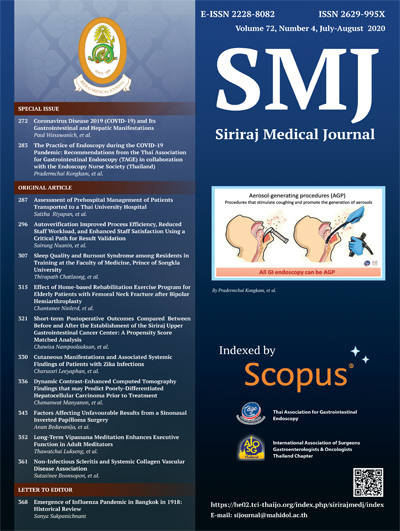Assessment of Prehospital Management of Patients Transported to a Thai University Hospital
DOI:
https://doi.org/10.33192/Smj.2020.39Keywords:
Emergency medical services, quality assessment, prehospital management, emergency departmentAbstract
Objective: To assess the quality of prehospital care given to patients transported to a Thai university hospital.
Methods: This prospective observational study collected data from EMS providers who transported patients to Siriraj Hospital during August 2017 to November 2017. Collected data was evaluated by at least 2 EMS medical directors for appropriateness of EMS dispatch and prehospital care. The primary outcome was to determine the quality of prehospital management among patients transported by EMS. Inter-rater variability in the evaluation of patient care between EMS medical directors and medical providers in the emergency department (ED) was performed using Cohen’s kappa coefficient, with a value lower than 0.7 indicating significant variability.
Results: Data was collected from 246 EMS providers that transported patients to our center. Evaluation by EMS medical directors found EMS dispatch to be appropriate in 216 cases (87.8%), and patient management to be appropriate in 198 cases (80.5%). Inappropriate prehospital management was found most often in patients who presented with out-of-hospital cardiac arrest (OHCA) (87.5%), and with chest pain (63.6%). Medical providers in the ED rated prehospital management to be appropriate in 93.1% of cases. Cohen’s kappa coefficient between EMS medical directors and ED providers was 0.2, which indicates significant variability between the two groups of assessors.
Conclusion: Quality assessment of the Thai EMS system revealed opportunities for improvement in prehospital management of patients dispatched by Thai EMS. Moreover, this study found variability in the evaluation of prehospital care between medical providers at the ED and EMS medical directors. Information from this study will help to influence and guide improvement in prehospital patient care in Thailand.
References
2. Laffel G, Blumenthal D. The case for using industrial quality management science in health care organizations. JAMA 1989;262(20):2869–73.
3. Sasson C, Rogers MAM, Dahl J, Kellermann AL. Predictors of survival from out-of-hospital cardiac arrest a systematic review and meta-analysis. Circ Cardiovasc Qual Outcomes 2010;3(1):63–81.
4. Baker A. Crossing the quality chasm: a new health system for the 21st century. BMJ 2001;323(7322):1192.
5. Dunford J, Domeier RM, Blackwell T, Mears G, Overton J, Rivera-Rivera EJ, et al. Performance measurements in emergency medical services. Prehospital Emerg Care 2002;6(1):92–8.
6. Al-Shaqsi SZK. Response time as a sole performance indicator in EMS: Pitfalls and solutions. Open Access Emerg Med 2010;2:1–6.
7. Pickering A, Mason S, Turber J, Bradley P, Irving S. Emergency services review: a comparitive review of international ambuance service best practice. London: National Health Service; 2009
8. Myers JB, Slovis CM, Eckstein M, Goodloe JM, Isaacs SM, Loflin JR, et al. Evidence-based performance measures for emergency medical services systems: A Model for Expanded EMS Benchmarking. Prehospital Emerg Care 2008;12(2):141–51.
9. Ting HH, Krumholz HM, Bradley EH, Cone DC, Curtis JP, Drew BJ, et al. Implementation and integration of prehospital ECGs into systems of care for acute coronary syndrome. Circulation 2008;118(10):1066-79.
10. Canto JG, Rogers WJ, Bowlby LJ, French WJ, Pearce DJ, Weaver WD, National Registry of Myocardial Infarction 2 Investigators. The prehospital electrocardiogram in acute myocardial infarction: is its full potential being realized? J Am Coll Cardiol 1997;29(3):498-505.
11. Ibanez B, James S, Agewall S, Antunes MJ, Bucciarelli-Ducci C, Bueno H, et al. 2017 ESC Guidelines for the management of acute myocardial infarction in patients presenting with ST-segment elevation. Eur Heart J 2017:1–66.
12. Zedigh C, Alho A, Hammar E, Karlsson T, Kellerth T, Svensson L, et al. Aspects on the intensity and the relief of pain in the prehospital phase of acute coronary syndrome: Experiences from a randomized clinical trial. Coron Artery Dis 2010;21(2):113–20.
13. Munk MD, White SD, Perry ML, Platt TE, Hardan MS, Stoy WA. Physician medical direction and clinical performance at an established emergency medical services system. Prehospital Emerg Care 2009;13(2):185–92.
14. Report of Thai Emergency Medical Service System [Internet]. Nonthaburi: National Institute for Emergency Medicine; 2017 March 30 [updated 2017 June 15; cited 2018 March 30]. Available from: http://www.niems.go.th/th/DownloadFile.aspx?CateType=DataService&ContentId=25600330122905886
15. El Sayed MJ. Measuring quality in emergency medical services: a review of clinical performance indicators. Emerg Med Int 2012;2012:161630.
16. Rahman NH, Tanaka H, Shin S Do, Ng YY, Piyasuwankul T, Lin C-H, et al. Emergency medical services key performance measurement in Asian cities. Int J Emerg Med 2015;8:1-12.
17. Ong ME, Cho J, Ma MHM, Tanaka H, Nishiuchi T, Al Sakaf O, et al. Comparison of emergency medical services systems in the pan-Asian resuscitation outcomes study countries: Report from a literature review and survey. Emerg Med Australas 2013;25(1):55–63.
18. Hsieh MJ, Tang SC, Chiang WC, Tsai LK, Jeng JS, Ma MHM. Effect of prehospital notification on acute stroke care: A multicenter study. Scand J Trauma Resusc Emerg Med 2016;24(1):1–8.
19. Glober N, Sporer K, Guluma K, Serra J, Barger J, Brown J, et al. Acute stroke: current evidence-based recommendations for prehospital care. West J Emerg Med 2016;17(2):104–28.
20. Berglund A, Svensson L, Wahlgren N, von Euler M. Face arm speech time test use in the prehospital setting, better in the ambulance than in the emergency medical Communication Center. Cerebrovasc Dis 2014;37(3):212–6.
21. Cameron PA, Gabbe BJ, Smith K, Mitra B. Triaging the right patient to the right place in the shortest time. Br J Anaesth 2014;113(2):226–33.
Downloads
Published
How to Cite
Issue
Section
License
Authors who publish with this journal agree to the following conditions:
Copyright Transfer
In submitting a manuscript, the authors acknowledge that the work will become the copyrighted property of Siriraj Medical Journal upon publication.
License
Articles are licensed under a Creative Commons Attribution-NonCommercial-NoDerivatives 4.0 International License (CC BY-NC-ND 4.0). This license allows for the sharing of the work for non-commercial purposes with proper attribution to the authors and the journal. However, it does not permit modifications or the creation of derivative works.
Sharing and Access
Authors are encouraged to share their article on their personal or institutional websites and through other non-commercial platforms. Doing so can increase readership and citations.















